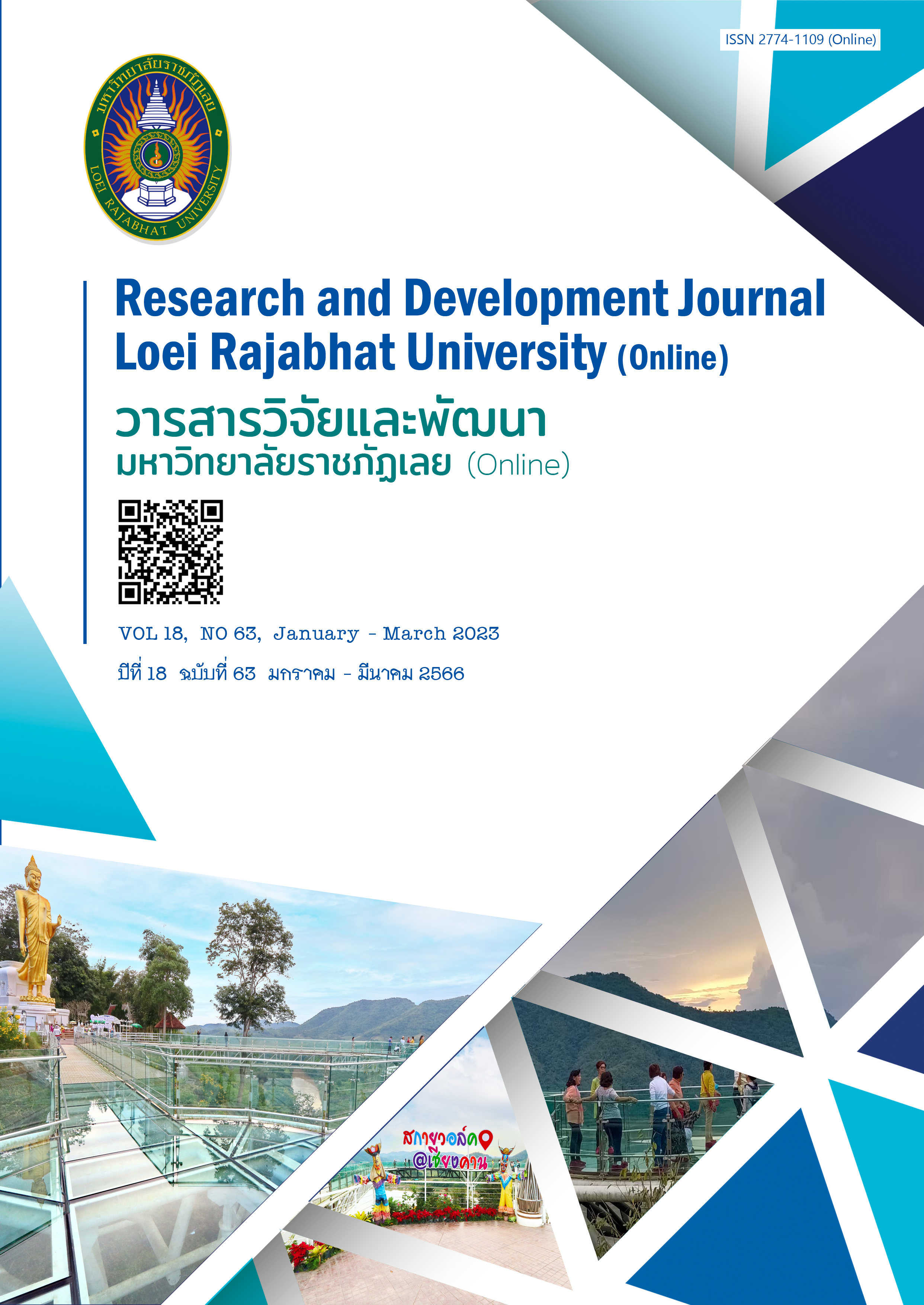A Study of Sacred Narratives in Loei Province Regarding the Roles of Cultural Interpretation and Natural Management
Keywords:
sacred narratives, cultural interpretation, natural management, Loei provinceAbstract
The objectives of the research entitled a study of sacred narratives in Loei Province regarding the roles of cultural interpretation and natural management were: 1) to analyze the role of cultural interpretation of sacred narratives; and 2) to analyze sacred narratives and the role of natural resource management by collecting data from document data and field study data in 5 districts of Loei Province along the Thai-Laos border, namely Na Haeo District, Dan Sai District, Chiang Khan District, Tha Li District, and Pak Chom District, and interviewing the informants, including community leaders, monks, ritual leaders, villagers, and the elderly from each district, 10 informants per district with the total number of 50 informants. The obtained data was analyzed and interpreted using myth and narrative theory, symbol and interpretation, and the concept of resource management wisdom. The results of the research were as follows.
Local sacred narratives in Loei Province had 6 aspects of cultural interpretation roles, namely: 1) communicating the fertility dimension through the names of Buddha images and sacred traditions through the postures of the Buddha image, ritual objects, and the water sprinkle ritual for Buddha images and lighting fireballs; 2) interpretating social and cultural meanings of the original Lan Xang through the ritual of Liang Hing Chao Mueang Wang; 3) interpretating Buddhism and original religious meaning by contrasting and transforming with each other; 4) Interpreting the meaning of the nation state after the Mekong River and the Hueang River became the bordering lined between Thailand and Laos regarding forms of fighting for natural resources through Songkran tradition and the fighting for resources to inherit the ethnic relation, government power and the relationship with Chao Pak Hueang, Phra Chao Ton Luang, and Pra Siang; 5) interpretating the meaning in terms of the relationship between Thai and Lao ethnography; and 6) interpreting the meaning in terms of gender roles which were not allowed to change the gender from female to male in Buddhism, female as a symbol of fertility, and the relationship between male and female.
Sacred narratives had roles in natural resource management and could be classified into 4 aspects as follows: 1) sacred narratives and wisdom in adapting people to the environment; 2) sacred narratives and wisdom in community natural resource conservation, classified into 3 issues: (1) the role of physical space creation, sacred space, and social space; (2) the role of social organization management of people in community and the use and the conservation of nature; and (3) the role of natural resource conservation in the community; 3) sacred narratives as the power of negotiation for the abundance of natural resources in forms of religion and food, and object-based negotiations, and the negotiation through behaviors and situations to satisfy the supernatural things in order to receive fertility; 4) Sacred narratives and rituals had roles in fighting and negotiating with government power for the conservation of natural resources, forests, and water, which can be classified into 3 case studies: (1) conservation of Phu Suan Sai Forest and Ban Saeng Pha in Na Haeo District, Loei Province; (2) conservation of community forests called Phu Tao Pong, Ban Boong Koom in Dan Sai District, Loei Province; and (3) conservation of water resources and Mekong fish species.
Sacred narratives linked to natural resources in Loei Province are considered a local wisdom in adapting human to human, human to nature, and human to supernatural things with roles of duty to convey cultural meaning and play a role in conserving natural resources, both directly and indirectly in which communities, society, and related organizations should preserve and used for further development and value creation.
References
กาญจนา แก้วเทพ. (2553). แนวพินิจใหม่ในสื่อสารศึกษา. กรุงเทพฯ: ภาพพิมพ์.
ธัญญา สังขพันธานนท์. (2556). วรรณคดีสีเขียว กระบวนทัศน์ และวาทกรรมธรรมชาติในวรรณคดีไทย. กรุงเทพฯ: นาคร.
ปฐม หงษ์สุวรรณ. (2550). กาลครั้งหนึ่ง: ว่าด้วยตำนานกับวัฒนธรรม. กรุงเทพฯ: สำนักพิมพ์แห่งจุฬาลงกรณ์มหาวิทยาลัย.
ปฐม หงษ์สุวรรณ. (2561). มองคติชน มุมสังคม หลักการ และแนวทางการศึกษาคติชนวิทยา. ขอนแก่น: โรงพิมพ์คลังนานาวิทยา.
พรสวรรค์ ศิริกัญจนาภรณ์. (2561). เรื่องเล่าไทยลาวกับความสัมพันธ์ของชุมชนสองฝั่งโขง. เลย: คณะมนุษยศาสตร์และสังคมศาสตร์ มหาวิทยาลัยราชภัฏเลย.
ศรีศักร วัลลิโภดม. (2555, 8 สิงหาคม). การศึกษาสังคมไทยผ่านภูมิวัฒนธรรม. สืบค้นจาก http://lek-prapai.org
ศิราพร ณ ถลาง. (2552). ทฤษฎีคติชนวิทยา วิธีวิทยาในการวิเคราะห์ตำนาน-นิทานพื้นบ้าน. กรุงเทพฯ: สำนักพิมพ์แห่งจุฬาลงกรณ์มหาวิทยาลัย.
สัณฐิตา กาญจนพันธุ์. (2554). ความคิดสีเขียว วาทกรรม และความเคลื่อนไหว. เชียงใหม่: สถาบันวิจัยสังคมและคณะสังคมศาสตร์ มหาวิทยาลัยเชียงใหม่.
อคิน รพีพัฒน์. (2551). วัฒนธรรมคือความหมาย: ทฤษฎี และวิธีวิทยาของคลิฟฟอร์ด เกียร์ช. กรุงเทพฯ: ศูนย์มานุษยวิทยาสิรินธร (องค์การมหาชน).
ผู้ให้สัมภาษณ์
พรนภา สิงห์หล้า. (2563, 15 ธันวาคม). ปราชญ์ท้องถิ่น. [สัมภาษณ์].
เฟือน บุตรวิไล. (2564,10 กุมภาพันธ์). ปราชญ์ท้องถิ่น. [สัมภาษณ์].
สัญญา สิทธิ. (2564, 5 มกราคม). ปราชญ์ท้องถิ่น. [สัมภาษณ์].
Downloads
Published
How to Cite
Issue
Section
License
Copyright (c) 2023 Research and Development Journal, Loei Rajabhat University

This work is licensed under a Creative Commons Attribution-NonCommercial-NoDerivatives 4.0 International License.
ข้อความที่ปรากฎในวารสารฉบับนี้เป็นความคิดเห็นของผู้เขียนแต่ละท่าน สถาบันวิจัยและพัฒนา มหาวิทยาลัยราชภัฏเลย และกองบรรณาธิการ ไม่จำเป็นต้องเห็นด้วยและไม่มีส่วนรับผิดชอบใดๆ
สถาบันวิจัยและพัฒนา มหาวิทยาลัยราชภัฏเลย ขอให้ผู้อ่านอ้างอิงในกรณีที่ท่านคัดลอกเนื้อหาบทความในวารสารฉบับนี้






